Chlorine is your pool’s immune system, without it, your pool would become ill, wretched and die. OK, that was a little overdramatic, but without chlorine, your pool would turn green, scummy, and become your very own backyard mosquito hatchery. And for this reason, we must keep our chlorine in check.
But what happens if your chlorine is “too” in check? By that, I mean too much cyanuric acid (CYA), and not enough chlorine.
What Is Chlorine Lock?
The phenomenon of “Chlorine Lock” occurs when a pool’s free chlorine (FC) is overpowered by its cyanuric acid (also known as CYA or Stabilizer). Though CYA is vital in stabilizing (hence the name) chlorine for sanitation, too much of it decreases the effectiveness of chlorine. The sudden drop in your chlorine’s ability to kill bacteria, allows bacteria and algae to take over your pool quickly. Chlorine Lock can put your pool in a sort of limbo, where there is not enough chlorine to sanitize your pool properly, but not too little where a carnival of mosquitoes and algae come to party.
There are some pool boffins, and chemical whizzes that say Chlorine Lock does not exist their reasoning is that “Chlorine Lock” is more of an is an umbrella term that overstates an issue.
Why Does My Pool Need Cyanuric Acid?
Chlorine hates sunlight, because sunlight can burn off chlorine almost as fast as an algal bloom. Let’s look at it from a human perspective, what do you do to prevent sunburn? You use sunscreen. And that is where the cyanuric acid comes in, because CYA is chlorine’s sunscreen. The cyanuric acid shields chlorine from sunlight allowing it to seek and destroy any bacteria or virus in your pool. This relationship keeps everyone healthy.
Side note: If you want a really in-depth look at the relationship between chlorine and cyanuric acid, read our man Charlie’s article: The Relationship Between Chlorine and Cyanuric Acid
But When Does a Healthy Amount of Stabilizer Become Too Much Stabilizer?
Traditional Chlorine
| CYA Level | Minimum FC | Target FC | Shock FC |
|---|---|---|---|
| 20* | 2 | 3 - 5 | 10 |
| 30 | 2 | 4 - 6 | 12 |
| 40 | 3 | 5 - 7 | 16 |
| 50 | 4 | 6 - 8 | 20 |
| 60 | 5 | 7 - 9 | 24 |
| 70* | 5 | 8 - 10 | 28 |
| 80* | 6 | 9 - 11 | 31 |
| 90* | 7 | 10 - 12 | 35 |
| 100* | 8 | 11 - 13 | 39 |
| *Outside of recommended level |
Saltwater
| CYA Level | Minimum FC | Target FC | Shock FC |
|---|---|---|---|
| 60 | 3 | 4 | 24 |
| 70 | 3 | 5 | 28 |
| 80 | 4 | 6 | 31 |
| *Outside of recommended level |
Because CYA protects chlorine, if there is too much of it in your pool it blocks the chlorine from working. Unlike chlorine, CYA does not dissipate, the only way to lower your stabilizer levels is to drain and refill a portion of your pool water. Chlorine Lock generally happens in older pools that use dichlor or trichlor tabs. These tabs can contain up to 50-60 percent CYA. Eventually, this CYA builds up to levels that must be compensated for.
And thanks again to Trouble Free Pool (TFP) and their pool chemistry experts for creating this handy-dandy Free chlorine to CYA use chart. The first columns show your CYA level, the following columns list Minimum FC and Target FC level needed to maintain proper levels. And the last column denotes the level of FC needed to shock your pool.
How Do You Fight Chlorine Lock?
An easy way to fight Chlorine Lock is to add more non-stabilized chlorine or cal-hypo to up your FC levels. This can be done by adding high percentage pool shock or bleach (yes, the kind you find at those big box stores). But not the splashless bleach, because additives within the formula foul your water.
For you skim readers out there, here is a quick and easy process to break Chlorine Lock:
1) Test your water’s CYA Levels.
2) a) If CYA is low, use the TFP calculator chart to add the correct CYA dosage to pool.
b) If high, drain 10 percent of your water, then SLAM (Shock, Level and Maintain).
3) Retest your water and repeat step 2 if necessary.
If you have another way on how to avoid or break chlorine lock, please leave a comment down below.

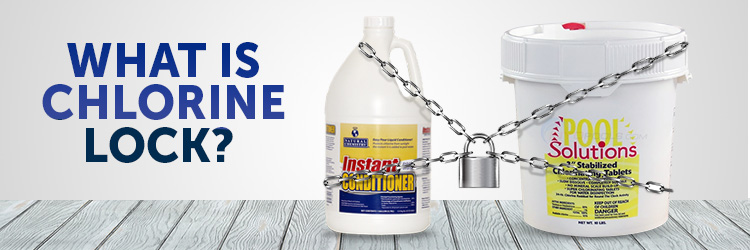
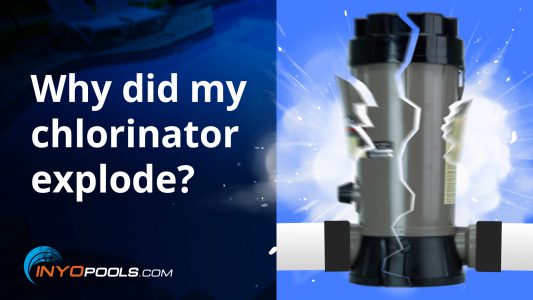
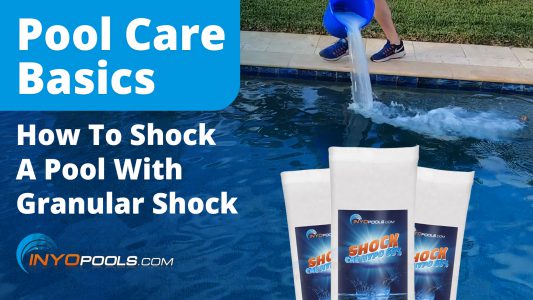
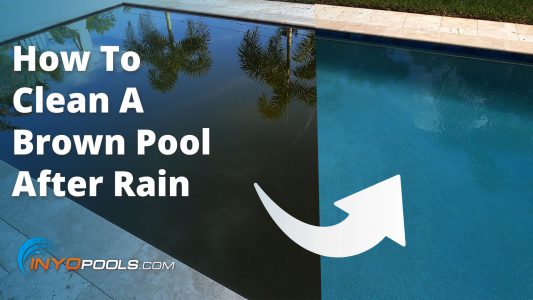
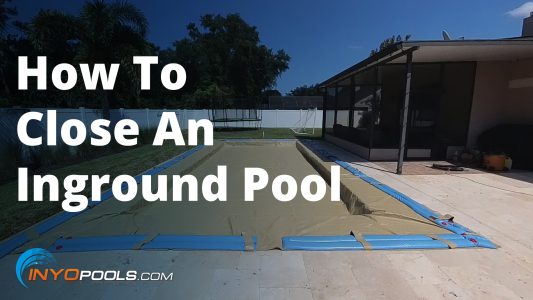






How do Get a better free chlorine reading. My pool is a15 ft above ground with approximately 5,800 gals. DE filter. I just shocked the pool and still no free chlorine showing on test strip.
Below readings were before shocking.
Free chlorine reads – 0.49
Total chlorine – 2.76
Ph – 7.4
Total alkalinity – 133
Calcium hardness – 180
Cyanuric acid – 51
Iron – 0.1
Copper – 0.2
Phosphates – 4000
TDS – 1100
My water is crystal clear with no chlorine smell. I would appreciate any help. Thank you.
Lower your phosphates because it is the only thing I can see that is out of whack. The water is clear, and there is no chlorine smell; It sounds like you have an almost perfect pool. Add some shock after removing the phosphates to boost the chlorine and resume your normal chlorinating routine.
Hi all,
I’ve heard contradictory statements on where to drain from to reduce CYA. I’ve seen a couple sites say CYA sits near the surface, so you should pump out some water from near the surface of the pool, and other sites saying it’s at the bottom of the pool, so use the main drain
Which is it? Or is it evenly distributed and removing any water is just fine
Thanks!
I have chlorine lock and need to drain off some water.Will this pool water kill my grass?
The water shouldn’t harm your lawn unless you have recently put in a dose of algaecide. You also want to make sure you don’t drown your lawn. move around the drain hose, so one spot does not get oversaturated.
Hope you can help me. Here are the current readings:
FC 0.14
TC 0.87
Combined 0.74
PH 7.5
Hardness 233
Alkalinity 111
CYA 2ppm
Pool is tinged green and cloudy. 40k gallons.
Pool store says it’s in lock, and wait a few days to let it burn up.
Should I be fixing the CYA levels now?
Please advise if that is the best approach.
Another way to break chlorine lock is to shock the pool with a non-chlorine shock. Non-chlorine shock oxidizes the water, restoring the balance and making it cleaner. To break chlorine lock with shock, breakpoint chlorination is being done.
No CYA chlorine lock? What else can cause this to happen? My total chlorine is higher but my free chlorine reads low. However, my pool is essentially indoors with no direct sun so I use no stabilizer. My CYA level is 0. My pool is also completely clear and not slippery?? Any thoughts??
It looks like you need to lower your chloramine level which can be done by dosing with non-chlor shock or with liquid shock. If your pool has a stronger “chlorine smell” than usual, that is from high levels of chloramines.
Hi, tanks for this information.
I rigourously measure free Chlorine, Combined Chlorine, pH, CYA & TA.
Current values:
* pH 7.3 (which I consider optimal?)
* TA 91 (I aim for 100, but since above 80, I consider this one quite ok)
* CYA 46 (…and climbing… I will start backwashing a bit more, and intend to drain the pool half soon)
* fCl 4.8
* cCl 0.3 (total Chlorine 5.1)
What puzzles me, is that at these levels of CYA, I will have to maintain high free Cl levels, according to the chart, above 5ppm.
Many websites mention that one should not swim in the pool if fCl is above 5ppm, because it’s considered unsafe?
Thanks in advance for clarifying this further to me
Your Total Chlorine is too high, add some liquid shock or non-chlor shock to bring down your chloramines.
I’m certain I have chlorine lock… while I do have my water tested at a pool supply shop, the usual response from whatever kid they put behind the desk will say to continue to add more shock to the pool. Somehow I think this puts me in a worse state that before. Now I have that nice bleachy smell.
Here are my latest readings: FC .24ppm, TC 1.24, Combined Chlorine 1ppm, Ph 7, Alk 75 PPM, CA 50 PPM, HARDNESS 318.
How do I proceed to break the lock???? Help needed!!
One way to break the chlorine lock is shocking your pool with non-chlorine shock. Non-chlorine shock oxidizes the water, restoring the balance and making it cleaner. To break chlorine lock with shock, breakpoint chlorination is being done.
Does it make since that pool people tell me that I have a chlorine lock , but I need to add more stabilizer?
What are your stabilizer levels? That’s an important bit of information.
I have a 30k gallon pool and I’m testing with strips. Two brands of strips are identical. I think I have Chlorine lock. I opened the pool 2 days ago and it was blue but foggy. It went green fast. Went to a pool store and they said I probably had chlorine lock. All my levels are fine except FC. In fact the store said my CYA was low. It’s been 48 hours, 18 gallons of liquid chlorine and 8lbs of shock later. I’ve also drained 15% of my pool and refilled it. The green is gone but it’s foggy and reading no FC and high high Total Chlorine. What am I doing wrong?
First, did you add the necessary CYA? There is no chlorine because it was used up killing the algae, which has now become that cloudiness. Use a clarifier or a floccing agent to get rid of the dead algae, correct your CYA level,s then resume using liquid chlorine or tablets as normal.
I have a problem. I have a 10, 000 gal pool. I used a liquid natural stabilizer in my pool. Then I added 4 gal of pool chlorine. It would never register any stabilizer with my strips. Plus the chlorine never registered either. Next I gradually put in about 5 lbs of granulated stabilizer. The strips measured ok stabilizer after that. Next I added 4 more gal of pool chlorine. Nothing on the strips. Next thing that happened was a creamy slimy sludge was in my pool. I’m guessing it was the first stabilizer I put in. Next I backwashed to waste until I got the murky stuff out and added quite a bit of new water and gradually added 4 packages of shock. Of course then my stabilizer was back down and the chlorine has still never registered. Now after adding more stabilizer, it does not appear to be changing the reading at all. I’ve added so much stabilizer and chlorine that’s it’s scary. Any ideas??
Do you have the results of your latest water tests? We need to know the full picture, including the FC, pH, Alk, Calcium, and any other things your test kit can measure. Without actual numbers, I can’t give you a solid answer.
Good thought, I just tested it with my strips, but no. I can have the pool store test as
Let us know the results of the tests.
Matthew,
Thanks for the reply. I am going by the pool store tests, but my test strips do closely match the store tests. Can’t figure out why the cya did not drop with the 50% drain, and has gone up 60 points in the following 2 weeks with no shock or tabs being added. Even the chlorine level resisted change with the drain. Dropping down only 4 points with the drain.
Have your tested your tap water? It’s a longshot, but maybe your tap water has high CYA levels.
I have a similar issue. CYA was 124, I drained 1/2 the pool (5000 gal of 10000 total). CYA was still 120. I week later I did a NoPhos treatment to reduce phosphates. CYA is now 184. Chlorine level was at 10 before draining, now at 7, no shock added. Using floater.
How come my CYA did not lower with drain?
Are you using test strips or are you getting your water tested at a pool store? If the test strips are being used, I’d take it to a pool store, because they may be fouled.
I had a CYA level of 190 in my vinyl liner pool. So drained 2 feet of water and refilled with fresh and di no more chemicals at all. I had retested and it went up to 240. Why would it go up and what do I do to get it down? It seems the fresh water made it go up.
I definitely have chlorine lock. CYA is well over 200. I thought I should drain the pool and re-fill with fresh water. Local pool store tells me not to do that and to open the pool as normal, then they’ll help me re-balance it. I feel like it would be a waste of time and money to open the pool as normal (paying to re-fill to normal level) just to turn around and drain it again. Thoughts?
It sounds like you are leaving a big part of the background out of your question. How low is your water? If your pool is three-quarter empty, then filling it with fresh water could make the CYA balance out. If it is a third empty, then you need to drain more water to add more of the fresh.
It could be a greedy local pool store trying to get you waste money on a futile “rebalance.” Or they could be on the right path to fixing the issue. It all depends on the pool water level.
When we closed it, we drained it just below the slimmer and lights. Maybe a foot. It’s not even half empty. It’s an above ground 10,000 gallon pool for reference.
Knowing this, you’d drain more before filling it for summer? I’m afraid draining just half will only bring the CYA level to 100. I really think it needs to be almost completely drained. Or am I on the wrong track?
How much liquid chlorine or shock do I put in to break the lock after draining/refilling? I have a 10000 gal pool and have battled this lock all summer. I assume this has to be corrected before we close the pool for the summer?
Most pool shock package instructions state you would need 1 pound of shock per one pound 10,000 gallons. How much chlorine you would need after draining and refilling is dependent on the water chemistry (just like any other time you are balancing chemicals.) First, test the water then added the necessary amount of chlorine. If you need a precise measurement, I suggest visiting the TFP PoolMath Calculator.
I have a CYA reading of somewhere around 100, I cannot get a much more accurate reading due to test strips only reading 0, 30-50, 100, 150, 240 and cannot find anybody local who can analyse my water. Also locally all are tabs and shock are trichlor or dichlor.
I am assuming I have to drain off water to fix CYA issue but with trichlor tabs will it just go back up?
First, I would get a different testing kit because the ranges on that kit are way too wide to be able t figure out what needs to be done. There are tons of options out there, the best-reviewed manufacturer of test kits are Taylor. And again, you can buy shock, chlorine, and other types of chemicals online as well. The trichlor will eventually bring up the stabilizer level but it won’t boost it to where it will be a problem right away. You may also use cal hypo shock to boost the chlorine levels.
We have recently had an algae bloom
Did the SLAM only to have it return within two days. My chlorine is reading very high and the cYA level is between 225-275. I think I have a chlorine lock, any suggestions.
Becka, just a quick glance at the chart in the article should tell you your CYA level is like three times higher than it should be. You need to drain a large portion of your water and fill with fresh to try to get the CYA levels in check. With CYA levels that high you may as well not put any chlorine in there until you drain and fill.
My CYA has been high all summer. I have drained some and refilled some for a few months. It has come down some but not at normal level yet. It has been exhausting trying to keep chlorine in the pool without using my chlorinator. Can you put a NST chlorine tablet in skimmer? The beginning of your article says NO but manufacturer of the NST chlorine tablet says to ONLY put tabs in skimmer. Can I use a floater instead?
Yes, use a floater.
If your CYA levels aren’t dropping, you may not be draining enough water. Draining, refilling and then draining again is not as effective as doing a longer initial drain.
Seem to be having the same issue with my chlorine but before I take action I want to ad that I did a stain removal last week. Water was crystal clear then over a couple days went to a bluish cloudy color and now I can’t get my chlorine to come back up. I’m getting 0 FAC, 0 TAC, Cya is 80, TA 110 and pH is 7.6.
Your CYA is above the normal level, get that in check. Your chlorine is nonexistent, so that haze could be a algae problem that is blooming/dying out. Drain water to get CYA down, add pool shock and regular chlorine to kill any lingering nasty stuff, then use a clarifier to get it out of your pool.
NST Tabs , Poolife are Awesome! No Cya and Only Go In the Skimmer, A Must Know, Only Skimmer.. Until Lonza sells the Exact Chlorinator To Usebwith Them.. Natural Chemistry can help cut down the CYA, Bio-Active did not work well at all for me.
I cringe anytime I see tablets in a skimmer. Putting tablets in a skimmer will quickly destroy the pumps shaft seal leading to leaking and shortened motor life.
I have seen skimmer lines so blistered , from tabs in skimmer, that water flow was almost non existent .
Ive been putting 3 inch tabs in my skimmer basket for 24 years and never had an issue with the pump. i know many others that do it the same way. The trick is to not let it sit in the skimmer over night . Take the basket out so the chlorine doesnt build up and send a super shot of concentrated chlorine to the pump as this would potentially cause damage or shorten longevity
Or, you can buy a chlorine float which is essentially the same thing except you do not have to put in/remove the tablet container every morning and evening.
You should point out that the second chart showing CYA of 60-80 is for pools with a salt water chlorine generator.
Yes, it should have been labeled. Chart titles have been added.